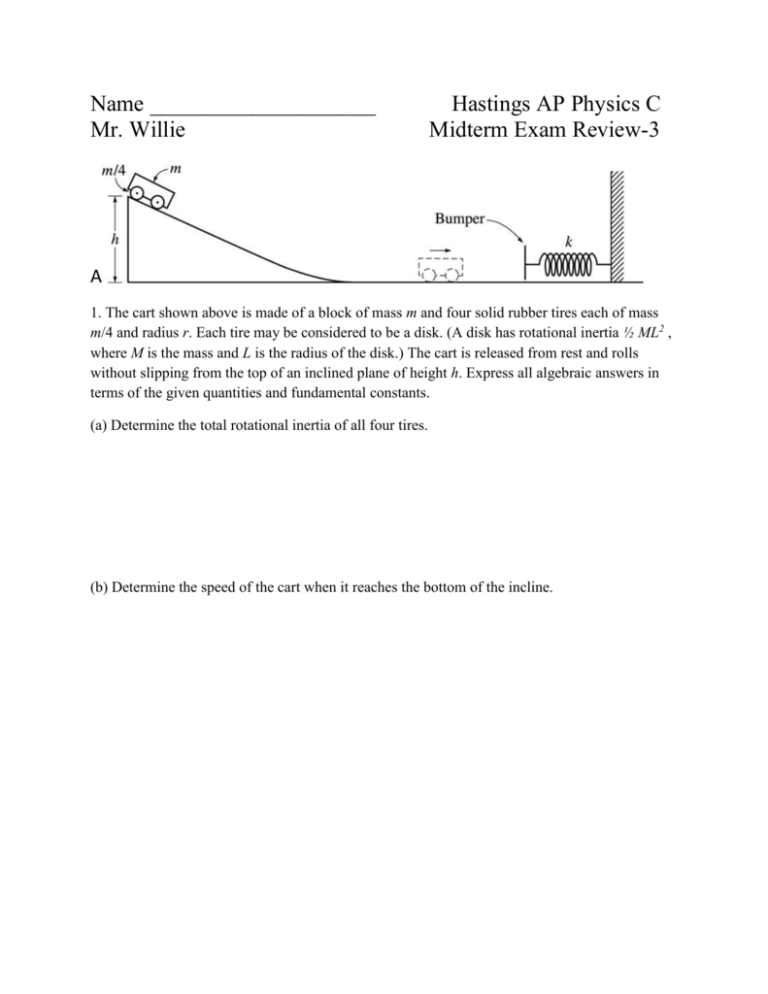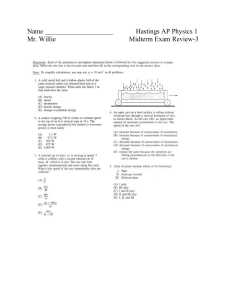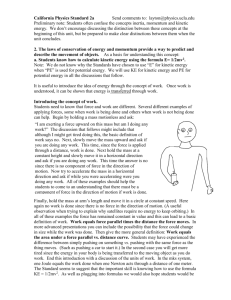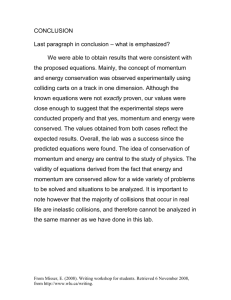Name Hastings AP Physics C Mr. Willie Midterm Exam Review
advertisement

Name ____________________ Mr. Willie Hastings AP Physics C Midterm Exam Review-3 A 1. The cart shown above is made of a block of mass m and four solid rubber tires each of mass m/4 and radius r. Each tire may be considered to be a disk. (A disk has rotational inertia ½ ML2 , where M is the mass and L is the radius of the disk.) The cart is released from rest and rolls without slipping from the top of an inclined plane of height h. Express all algebraic answers in terms of the given quantities and fundamental constants. (a) Determine the total rotational inertia of all four tires. (b) Determine the speed of the cart when it reaches the bottom of the incline. Free Response 1. (continued) (c) After rolling down the incline and across the horizontal surface, the cart collides with a bumper of negligible mass attached to an ideal spring, which has a spring constant k. Determine the distance xm the spring is compressed before the cart and bumper come to rest. (d) Now assume that the bumper has a non-negligible mass. After the collision with the bumper, the spring is compressed to a maximum distance of about 90% of the value of xm in part (c). Give a reasonable explanation for this decrease. 2. You are to perform an experiment investigating the conservation of mechanical energy involving a transformation from initial gravitational potential energy to translational kinetic energy. (a) You are given the equipment listed below, all the supports required to hold the equipment, and a lab table. On the list below, indicate each piece of equipment you would use by checking the line next to each item. ____ Track ____ Cart ____ String ____ Meterstick ____ Electronic balance ____ Stopwatch ____ Set of objects of different masses ____ Lightweight low-friction pulley (b) Outline a procedure for performing the experiment. Include a diagram of your experimental setup. Label the equipment in your diagram. Also include a description of the measurements you would make and a symbol for each measurement. (c) Give a detailed account of the calculations of gravitational potential energy and translational kinetic energy both before and after the transformation, in terms of the quantities measured in part (b). 2. (continued) (d) After your first trial, your calculations show that the energy increased during the experiment. Assuming you made no mathematical errors, give a reasonable explanation for this result. (e) On all other trials, your calculations show that the energy decreased during the experiment. Assuming you made no mathematical errors, give a reasonable physical explanation for the fact that the average energy you determined decreased. Include references to conservative and nonconservative forces, as appropriate. 3. A skier of mass m will be pulled up a hill by a rope, as shown above. The magnitude of the acceleration of the skier as a function of time t can be modeled by the equations a = amaxsinπt/T =0 (0 < t < T) (𝑡 ≥ 𝑇) where amax and T are constants. The hill is inclined at an angle ɵ above the horizontal, and friction between the skis and the snow is negligible. Express your answers in terms of given quantities and fundamental constants. (a) Derive an expression for the velocity of the skier as a function of time during the acceleration. Assume the skier starts from rest. (b) Derive an expression for the work done by the net force on the skier from rest until terminal speed is reached. 3. continued (c) Determine the magnitude of the force exerted by the rope on the skier at terminal speed. (d) Derive an expression for the total impulse imparted to the skier during the acceleration. (e) Suppose that the magnitude of the acceleration is instead modeled as a = amaxe–πt/2T for all t > 0 , where amax and T are the same as in the original model. On the axes below, sketch the graphs of the force exerted by the rope on the skier for the two models, from t = 0 to a time t > T . Label the original model F1 and the new model F2 . mgsinɵ T Question 1 15 points total Distribution of Points (a) 2 points For determining the rotational inertia of each tire 1 1𝑚 2 1 𝐼 = 𝑀𝐿2 = 𝑟 = 𝑚𝑟 2 2 24 8 For the correct total rotational inertia for all 4 tires 1 𝐼𝑡𝑜𝑡 = 4𝐼 = 𝑚𝑟 2 2 1 point 1 point (b) 7 points For an indication of the conservation of mechanical energy Etop = Ebottom ; ∆U=-∆K ; or equivalent 1 point For correct expressions for energies at the top Ktop = 0; Utop _ mgh + 4(mgh/4)= 2mgh 1 point For a correct expression for potential energy at the bottom and that kinetic energy at the bottom is the sum of translational and rotational kinetic energies Ubottom = 0; Kbottom = Ktrans + Krot 1 point For a correct expression for translational kinetic energy at the bottom Ktrans = 1/2 (2m)υ2 = mυ2 1 point For a correct expression for rotational kinetic energy at the bottom Krot = Iω2/2 1 point For recognition of the relationship between translational and rotational velocity ω=v/r 1 point Substituting these expressions to determine total kinetic energy at the bottom 1 1 𝑣2 5 𝐾𝑏𝑜𝑡𝑡𝑜𝑚 = 𝑚𝑣 2 + ( 𝑚𝑟 2 ) 2 = 𝑚𝑣 2 2 2 𝑟 4 Setting potential energy at the top equal to the kinetic energy at the bottom 5mυ2/4 = mgh For the correct solution for v 8 𝑣 = √ 𝑔ℎ 5 1 point (c) 4 point Distribution of points For recognition that energy is conserved (Although it is an inelastic collision, the mass of the bumper is negligibly small, thus its kinetic energy is negligible and there is no loss of energy.) 1 point For a correct expression for potential energy of the spring at maximum compression UK = kxm2/2 1 point For applying conservation of energy by equating the potential energy of 1 point the spring at maximum compression EITHER to the gravitational potential energy of the cart and wheels at the top of the inclined plane OR to the kinetic energy of the cart and wheels at the bottom of the inclined plane 1 1 5 2 2 𝑘𝑥 = 2𝑚𝑔ℎ OR 𝑘𝑥 = 𝑀𝑣 2 𝑚 𝑚 2 2 4 For a correct solution of either of these equations for xm (including a correct substitution for v from part (b) for the second equation) or an answer consistent with work done in (b) 𝑥𝑚 = 2√ 1 point 𝑚𝑔ℎ 𝑘 (d) 2 points For an explanation that discusses the inelastic collision with a loss of mechanical energy or a reduced velocity resulting in a smaller compression. The discussion should have been correctly stated. If there were any incorrect statements, then 1 point was subtracted. Points were neither added or subtracted for irrelevant statements, such as references to friction. 2 points Question 2 15 points total Distribution of points (a) 1 point For choosing the meterstick and stopwatch, regardless of what else is checked 1 point (b) 4 points For a procedure that indicates the height needed to calculate gravitational potential Energy 1 point For a procedure that indicates distance and time measurements to calculate velocity For a diagram and a clear indication of the height measurement For a diagram and a clear indication of the distance measurement 1 point 1 point 1 point Example #1 mc mb H h Use the electronic balance to determine the mass mc of the cart and the mass mb of one object. Attach the object to the cart using the string. Place the cart on the track and hang the object so that the string passes through the pulley. Allow the object to fall a distance h from its initial position to the floor, using the meterstick to measure the distance fallen. Use the stopwatch to measure the time t it takes the object to fall the distance h. Measure the height H of the table. Question 2 (continued) Distribution of points (b) continued Example #2 d h Use the electronic balance to determine the mass m of the cart. Set the track at an incline, and measure the height h of the incline. Place the cart at the top of the incline, and release from rest. Using the stopwatch, measure the time t it takes for the cart to move down the incline. Measure the distance d that the cart moves down the incline. (c) 6 points For a clear indication of the initial potential energy of the system For a clear indication of the final potential energy of the system For a clear indication of the initial kinetic energy of the system For a clear indication of the final kinetic energy of the system For a correct calculation of the instantaneous velocity of the system Example #1 Initial gravitational potential energy: Ug0 = mcgH + mbgh Final gravitational potential energy: Ugf = mcgH Initial kinetic energy: K0 = 0 Final kinetic energy: Kf = ½(mc+mb)vf 2 Acceleration is constant, so d = 1/2(vo+vf)t, where d is the distance along the track. vf = 2h/t 1 point 1 point 1 point 1 point 2 points Question 2 (continued) Distribution of points (c) continued Example #2 Initial gravitational potential energy: Ug0 = mgh Final gravitational potential energy Ugf = 0 Initial kinetic energy K0 = 0 Final kinetic energy K0 =1/2mv2 Acceleration is constant, so d = ½(vo+vf)t vf = 2d/t (d) 2 points For identifying a reasonable cause for the increase in energy 1 point For a reasonable explanation related to the cause identified 1 point Example An unintentional push was applied to the cart, thus increasing the initial energy. (e) 2 points For identifying a reasonable cause for the decrease in energy related to the nonconservative forces acting on the system 1 point For a reasonable explanation related to the cause identified 1 point Example Friction acting on the object decreases the speed, thereby decreasing the energy.









